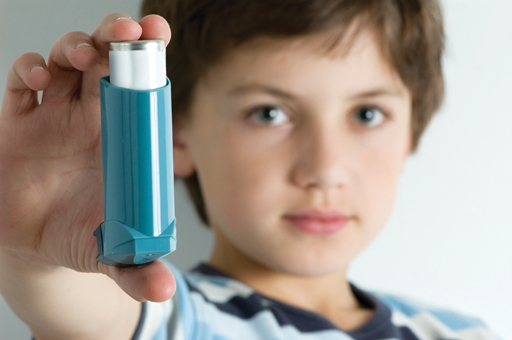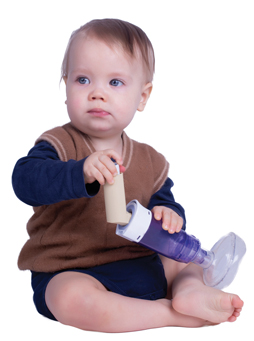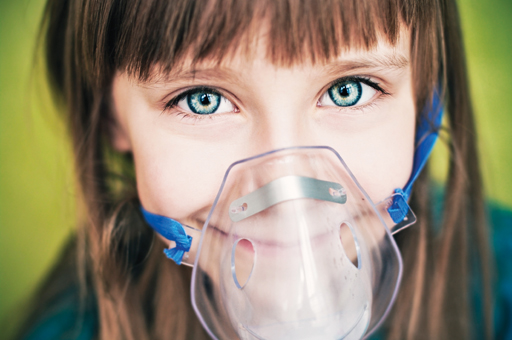Managing childhood asthma
In Clinical
Follow this topic
Bookmark
Record learning outcomes
Community pharmacy is well placed to help children and young people with asthma gain better control over their condition

Learning objectives
After reading this feature you should be able to:
- Understand the factors affecting poor asthma management in children and young people
- Encourage all children and young people with asthma to have an action plan
- Help improve inhaler technique and medicine adherence.
There are 1.1 million children with asthma in the UK, of which more than 200,000 are living in London. On average, every classroom in the UK contains three children with asthma. A child is admitted to hospital every 20 minutes because of an asthma attack. Despite the high prevalence and severity of childhood asthma, the condition is frequently trivialised, while the care that children and young people with asthma receive is often inconsistent.
Childhood asthma has various risk factors, including low birthweight or premature birth, family history of atopy, smoking during pregnancy or parents who smoke, and multiple environmental factors. There is evidence to suggest that long-term exposure to high concentrations of air pollutants increase the chances of a child developing asthma, with asthma prevalence tending to be higher in big cities.
Evidence is growing to support community pharmacists' role in the management of asthma in adults €“ and according to NHS England's head of primary care commissioning for dentistry, optometry and pharmacy in London and Healthy London Partnership pharmaceutical adviser, Donal Markey, there is much they can do to support children and young people as well.
€As an easily accessible source of advice and support, community pharmacists have a vital role to play in supporting and educating children and young people with asthma and their families,€ he says.
Inhaler technique
 An audit carried out in over 1,000 community pharmacies across London in 2015 found that emergency salbutamol inhalers had been requested for one in four children with asthma in the past 12 months. This suggests that poor control of the condition is widespread across the capital. There are various factors that can affect asthma management in children but one of the commonest reasons for poor control is the incorrect use of inhalers.
An audit carried out in over 1,000 community pharmacies across London in 2015 found that emergency salbutamol inhalers had been requested for one in four children with asthma in the past 12 months. This suggests that poor control of the condition is widespread across the capital. There are various factors that can affect asthma management in children but one of the commonest reasons for poor control is the incorrect use of inhalers.
€Common mistakes include not shaking the inhaler beforehand and not breathing out before inhaling the dose. Another common issue is the absence of a spacer device in younger children or the reluctance to use one in older children and adolescents,€ says Donal Markey. €When inhalers aren't used properly they are less effective and the chances of a life-threatening asthma attack increase.
Dr David Finch, GP lead for asthma care at the Healthy London Partnership, says that, even when spacers are used, the wrong type of spacer for the inhaler or the child's age is sometimes selected, €which means the drug isn't delivered correctly into their lungs€. In addition, crying while using a spacer affects drug delivery in infants because €most of their breath is going out rather than in€, while children and families often confuse the preventer and reliever inhalers.
Less common mistakes can occur when parents have received little support on managing their child's asthma and are confused about how to administer the medication. Dr Samantha Walker, director of research and policy at Asthma UK, says she has even come across cases where parents have puffed the inhaler into a child's bedroom or directly onto a pet that is triggering the symptoms.
Given the level of confusion surrounding inhaler use, it is essential that pharmacists ask young patients to demonstrate their inhaler technique (rather than just asking them about it), especially as children and their parents are often unaware that there is a problem.
Sleep matters
Sleep is crucial for the healthy development of a baby and night-time sleep is particularly important as it includes REM (rapid eye movement) sleep €“ the stage during which memories are consolidated and neural pathways laid down. However, babies will wake during the night to feed and various other factors can disturb their sleep, including being too hot or too cold, teething, fever, a wet nappy or changes in routine.
Speaking at the launch of New Pampers Baby-Dry, sleep expert Jo Tatum said: €REM sleep tends to happen towards the end of the night and it is also when the most movement takes place. It is therefore important to remove and reduce any factors that may disrupt this important sleep period for the baby. A baby will urinate approximately three to four times during the night. As the night goes on, the nappy poses an increased risk of disturbing the baby through wetness and bulk, which makes them generally uncomfortable.€
Adherence issues
Besides poor inhaler technique, children and young people may underuse or fail to take their medication altogether. Part of the problem, according to Dr Walker, is that asthma symptoms can fluctuate over time, leading to complacency and adherence issues.
€Asthma is a chronic remitting-relapsing condition that can change over a lifetime and from year to year or month to month,€ she says. €For example, a child may have a particularly bad summer followed by five months of being asymptomatic. Once the symptoms go away, people may not see why they need to keep taking their medicines.€
Children are particularly likely to slip out of the routine of using their preventer inhaler during the summer holidays, which increases their vulnerability to asthma attack triggers, such as air pollutants, mould spores and viruses, when they return to school in the autumn. Research by Asthma UK suggests that children aged 14 years and under are almost three times more likely to be admitted to hospital with asthma in September compared to August.
In addition, older children and teenagers may avoid using or carrying their inhaler due to embarrassment or not wishing to be seen to be different from their peers.
A simple but highly effective way of helping to overcome adherence issues and improve asthma management in children and young people is to ensure that they have a personalised asthma action plan agreed and understood by the child, their family and doctor.
€The plan should help parents or young people recognise when their symptoms are getting worse and give advice on what to do,€ explains Dr Finch. €It should have information on triggers; how and when to use treatment; how to spot asthma getting worse (symptoms and peak expiratory flow); what treatment to use in an emergency; and how and when to call for help.€
Research suggests that children with asthma action plans are four times less likely to be admitted to hospital than those without, yet uptake of plans is poor across the UK. The London pharmacy audit revealed that less than 52 per cent of children and young people with asthma in London have one.
Asthma UK advises patients to:
- Keep their plan in a place where they can access it easily, such as on the fridge, and/or to take a photo of it on their phone
- Take the plan to all their asthma reviews and appointments
- Share copies with family members, friends and teachers.
It is recommended that children receive an asthma review from a healthcare professional every six months. Dr Walker urges community pharmacists to ensure that children and young people with asthma have an asthma action plan, and if they don't to refer them to their GP or recommend that they download a plan template from asthma.org.uk/resources.

Perceptions
An underlying factor contributing to poor asthma management in children and young people is the commonly held misconception that the condition is a minor or trivial childhood illness when, in fact, asthma kills the equivalent of a classroom of children every year in the UK, according to the National Review of Asthma Deaths 2014.
€Many children have to take time off school because of their asthma, which can affect their education and have a major impact on their life,€ says Donal Markey. €Spending time in hospital can be distressing, while parents often have to take time off work to care for them.€
Dr Walker regrets that the condition tends to get trivialised as €just asthma€ due to the fact that it affects so many people. Asthma is the most prevalent long-term condition in the UK, with 5.4 million people currently receiving treatment for it. On average, three people a day die from asthma, but families are often unaware that the condition can be deadly.
€Complacency is an issue but we don't want families to live in constant fear,€ she says. €One way of explaining how serious asthma can be is to compare it with playing near water unattended. Like the sea, asthma can quickly change from something fairly benign into something very dangerous.€
Overdiagnosis?
Earlier this year, two leading respiratory doctors proposed that a contributing factor to poor asthma management and outcomes in children is the fact that the condition is being overdiagnosed. Writing in the Archives of Disease in Childhood in April, Professor Andrew Bush and Dr Louise Fleming of Imperial College and Royal Brompton & Harefield NHS Foundation Trust, argued that, while asthma was undoubtedly underdiagnosed in the past, these days inhalers are being €dispensed for no good reason€ and have become €almost a fashion accessory€.
The dangers of overdiagnosis are not only that genuine cases of asthma may be trivialised and overlooked, but also that children could be put at risk of serious adverse effects due to taking inhaled corticosteroids unnecessarily. Possible adverse effects include adrenal failure and growth suppression, along with the possibility of mucosal immunosuppression and an increased risk of respiratory infections.
Dr Walker agrees that there is a potential for children to be misdiagnosed with asthma due to the fact that there is no definitive diagnostic test, but disagrees that the condition is being widely overdiagnosed. Doctors diagnose asthma through a combination of the personal history of a patient's symptoms and lung function tests. In children the commonest signs and symptoms include coughing, wheezing, shortness of breath, a whistling sound from the chest and waking during the night with breathing difficulties.
€Diagnosis is often difficult in under-fives because there will not be a long personal history and because wheezing is not always due to asthma but can be caused by viral infections,€ she explains. €However, for every study suggesting that asthma is overdiagnosed, there is one suggesting that it is underdiagnosed.€
Due to the difficulties in asthma diagnosis, as well as the remitting nature of the disease, it is therefore essential that children with asthma be assessed continually to determine whether or not inhaled corticosteroids are appropriate. This uncertainty could be removed in the near future, however, with the development of a single diagnostic test on the horizon.
Pharmacy support
Last month, Healthy London Partnership and Education for Health launched an online asthma toolkit to support pharmacists, GPs, hospital staff, schools, parents and carers to provide the best care to children and young people with asthma. This was followed up with an online asthma learning hub to support London pharmacists to develop their skills and confidence in providing care to children and young people after the London pharmacy audit revealed that most resources focus on adults.
Developed with input from community pharmacists, the hub provides advice on conducting asthma MURs or NMS consultations with children and young people, including assessing inhaler technique, discussing the use of spacer devices, stressing the need to use preventer inhalers even when feeling well and details of common mistakes. The asthma learning hub and toolkit are available via myhealth.london.nhs.uk.
€If community pharmacists can offer an inhaler technique assessment through a MUR or NMS consultation to the regular child or young person we see with asthma, we can make a big difference in helping them to control their condition and reduce the risk of asthma attacks,€ believes Donal Markey.
€Pharmacists could play a greater role,€ adds Dr Finch. €Children or their parents tend to use the same pharmacy to collect their medication so build up a rapport with their local pharmacist. Pharmacists can use MURs or, as a minimum, check the child is using his/her inhaler correctly. They can also ask young people and parents about smoking and offer smoking cessation advice if appropriate.€
Alphega Pharmacy takes on child obesity
Alphega Pharmacy is launching a new family-based programme, Growing Healthy, to help tackle the increasingly serious issue of childhood obesity. Growing Healthy will be piloted in six pharmacies from next month, with a further roll-out expected in 2017 following an initial evaluation.
Consisting of 12 consultations over a six-month period, the programme uses interactive, child-focused activities such as jigsaws and card games, combined with motivational interviewing techniques, to support families to identify their unhealthy habits and choose healthier alternatives. Although primarily aimed at families who have overweight children, Growing Healthy is suitable for any family with a child aged four to 12 years old.
- Brush up on your asthma management CPD by searching for the word 'asthma' in the search box at the top of the page.
Asthma is a life-threatening condition that kills the equivalent of a classroom of children every year in the UK
